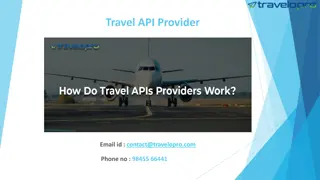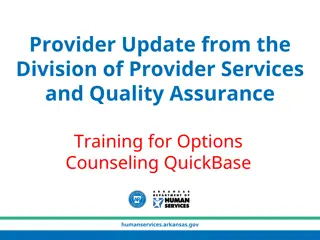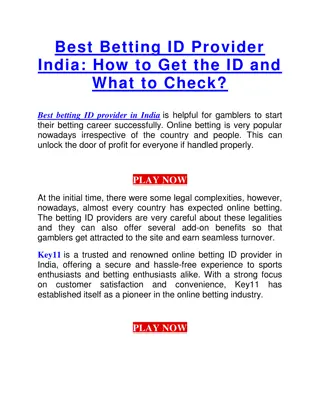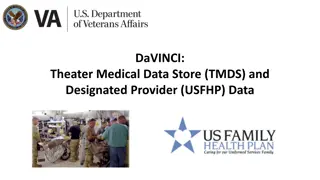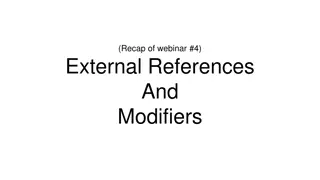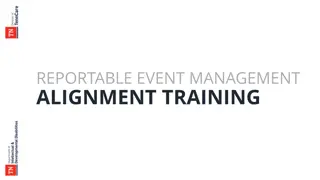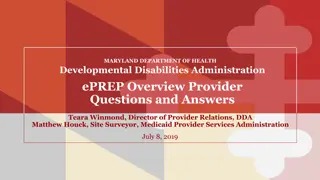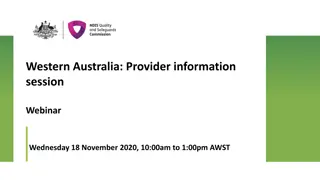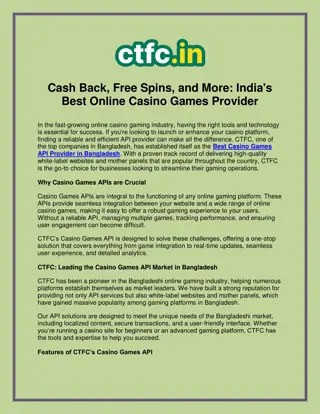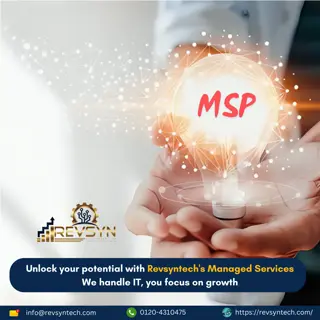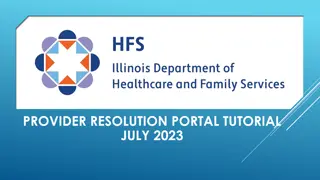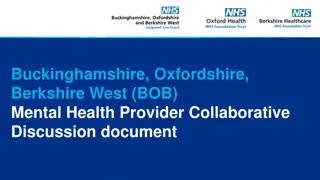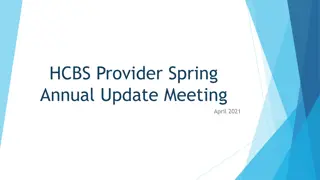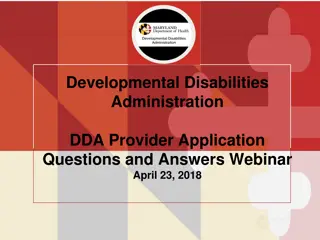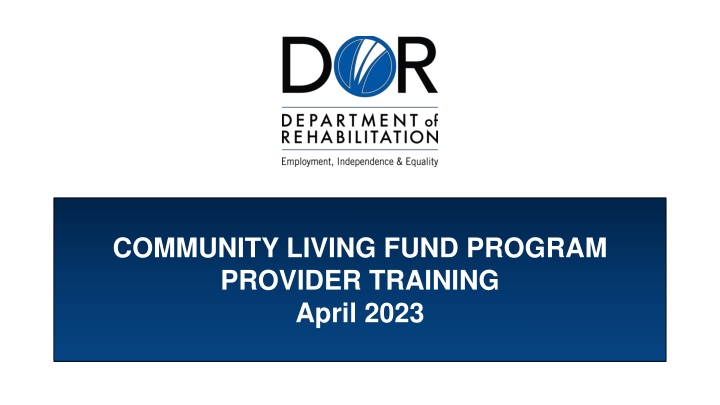
Community Living Fund Program Provider Training April 2023
Join the Community Living Fund Program Provider Training in April 2023 to learn about funding, payment, reporting outcomes, and preventing fraud. Get valuable insights from presenters on post-award processes. Discover the California Community Living Fund Program and its objectives in supporting older adults and individuals with disabilities.
Download Presentation

Please find below an Image/Link to download the presentation.
The content on the website is provided AS IS for your information and personal use only. It may not be sold, licensed, or shared on other websites without obtaining consent from the author. If you encounter any issues during the download, it is possible that the publisher has removed the file from their server.
You are allowed to download the files provided on this website for personal or commercial use, subject to the condition that they are used lawfully. All files are the property of their respective owners.
The content on the website is provided AS IS for your information and personal use only. It may not be sold, licensed, or shared on other websites without obtaining consent from the author.
E N D
Presentation Transcript
COMMUNITY LIVING FUND PROGRAM PROVIDER TRAINING April 2023
Housekeeping - Part I This meeting is being recorded If you are not speaking, please mute yourself To mute or unmute: Select the microphone icon on the meeting toolbar at the bottom of your screen Keyboard shortcut is Alt+A If joining by phone press *6 To speak or ask a question, please use the raise hand feature Click on the reactions button on the meeting toolbar and choose raise hand Keyboard shortcut is Alt+Y If joining by phone press *9
Housekeeping - Part II This meeting has live text captioning To see captions, select CC Live Transcript on the meeting toolbar Please use the chat function only to request assistance Chat is not accessible to everyone and can be distracting There will be time for questions before the meeting ends For Jaws users to turn chat on or off, press insert, the space bar, and the letter S If anyone is having issues with hearing or seeing the meeting, please send a private message or email to Kritika Devi, Kritika.Devi@dor.ca.gov
Meeting Agenda Welcome and Overview How to Request Funding How to Get Paid How to Report Outcomes Avoiding Fraud, Waste, and Abuse Questions and Answers
Welcome and Overview Presenters Ana Acton, DOR Deputy Director Regina Cademarti, Staff Services Manager II (Acting) Overview Learn about the post award processes including: How to request funding Invoice for services provided Reporting requirements
Community Living Fund Program One-time $10 million General Fund Available from July 1, 2022 through June 30, 2025 Advances efforts of California s Master Plan on Aging to prepare for its diverse aging population by 2030 Addresses long-standing system challenges impacting California s older adults, people with disabilities, and caregivers Provides person-centered institutional transition and diversion services for people of all ages and with any type of disability who do not qualify for existing services.
Driving Principles - Part I Act as bridge program, build capacity and coordinate with existing systems and programs to expedite the provision of goods or services not available through other means to individuals either transitioning to the community or at-risk of institutionalization. Support consumers with transition and diversion services navigate available resources and programs and to support community living.
Driving Principles - Part II Serve 1,360 individuals statewide by June 30, 2025, through 50 eligible disability and aging service providers Support consumers with transition and diversion services navigate available resources and programs and to support community living. Measure performance outcomes for the number of individuals successfully served through the transition and diversion services.
Implementation Update In December 2022, DOR released a Request for Information Awarded grants to 28 community-based organizations covering 41 counties Continue to process grants, execute contracts have been sent to the providers Target outreach to counties not currently served Continue to accept new applications to expand access to services in geographically underserved areas in California. Coordinate with the grantees on local and statewide outreach to promote services to eligible consumers
Important Update Consumer K Number - Part I No longer H now K Located in Grant Narrative and Grant Provisions Consumer K Number needed for all CLF forms and needs to be included on the consumer records the provider maintains onsite Comprised of the letter K and ten numbers: First two digits will correspond to the last two digits of the grant number Next four digits are the consumer s birth month and date (mmdd) Last four digits are the numerical invoice submission (first submission would be 0001, then 0002, etc.).
Important Update Consumer K Number - Part II For example, if a Grantee was assigned grant number 39904 and were serving their first consumer, who was born on March 3rd, the K Number would be K0403030001. K04 Identifies the grant number 0303 Identifies the consumer birth month and day 0001 Identifies the encumbrance and/or invoice number When put together, K040303001 would be submitted by the Grantee on the Request for Funding/encumbrance request, invoice, and consumer outcome report.
Expenses Eligible for Reimbursement Two categories of reimbursable CLF Program expenses: (1) Purchase of Goods and Services and (2) Expenses for Service Coordination Source: Community Living Fund Grant Provisions, General Conditions (3) Eligible Expenses and (4) Allowable Non-Personnel Expenses
(1) Purchase of Goods and Services Providers may be reimbursed up to $5,000 per consumer for direct purchase of goods and services for institutional transition and diversion. Flexible funds to meet the needs of the consumer that support the consumer s goal for institutional transition or diversion. Funding may be used for any of the following: transition services; diversion services; purchase of goods and services including equipment and training; physical location improvement; access to community services; and professional Services.
Purchase of Goods and Services Part I Equipment Purchase and Training Funding may be used to purchase: Equipment or assistive technology to prevent institutionalization, facilitate a transition, or assist consumers in activities of daily living. Training on the equipment or assistive technology purchased may be provided to the consumer
Purchase of Goods and Services Part II Physical Location Improvement Funding may be used to purchase: Home modifications including doors, paths of travel, installation of ramps, push button door openers, flashing alarms, grab bar installation, bathroom accessibility modifications, or other modifications needed to make the consumer s home more accessible. Basic household setup costs such as bedding, food staples, dishes, bathroom supplies, furniture, and toiletries. Moving expenses, credit check fees, utility setup and startup fees, pest inspections and extermination, or other related household goods and services.
Purchase of Goods and Services Part III Access to Community Services Funding may be used to purchase: Transportation to services that support transition or diversion. Including doctors and healthcare facilities, shopping for food and basic necessities, and other services and programs necessary for community living where no other transportation service exists. Orientation and mobility training to assist consumers in navigating their community efficiently and safely.
Purchase of Goods and Services Part IV Professional Services Funding may be used to purchase: Support personal care assistance needs until long-term solutions can be put into place through the In-Home Supportive Services Program, private pay, or other sources. Assessments and services from occupational, physical, or behavioral health therapists. Other Services Other items, services, or supports necessary for institutional transition and diversion.
Staff Expenses for Reimbursement Part - I Staff expenses for service coordination will be reimbursed for the services provided to each eligible individual at the following rates: Up to $4,500 for each consumer transition as detailed in your organization s approved grant Attachment F1: Transition Cost Proposal and Narrative Up to $2,500 for each consumer diversion as detailed in your organization s approved grant Attachment F2: Diversion Cost Proposal and Narrative
Staff Expenses for Reimbursement Part - II Staff time may be used to: Conduct outreach to individuals who can benefit from the CLF Program Conduct intakes and assessments to determine eligibility, person- centered plan development, and follow-up services Collaborate with other organizations and programs to address a consumer s needs for transition or prevent institutionalization Identify other services consumers are eligible for and connecting them with those services Coordination of the purchase of all proposed goods and services
Request for Funding Form Part I Purpose Reserves funding Provides commitment of the provider of projected expenses Provides demographic information on consumer Ensures eligibility is determined Provides the justification of the services being provided to the consumer. Helps staff determine how much funds are available Fund Utilization Use funds within 90 days from requested/encumbered
Request for Funding Form Part II Process Email completed Request for Funding forms to CLF@dor.ca.gov 72 hour turnaround time Reminders One form per consumer Community Living Fund Program Services cannot be provided to consumers prior to a Request for Funding approval. Utilize funding within 90 days from requested/encumbered Inform CLF Program Staff if more time is needed
Request for Funding Form Part III Let s View the Form Instructions and the form was sent before this training and will be posted to the DOR Community Living Fund website https://www.dor.ca.gov/Home/CommunitylivingFund
Invoicing Part I Purpose First step for provider to receive payment Itemizes and records the goods and services and/or staff time provided Provides proof of purchases Receipts are required for reimbursement for purchases of goods and services. Critical element for accounting and internal controls Allows DOR to disencumber funds
Invoicing Part II Process Email completed invoice form to CLF@dor.ca.gov CLF staff will review and approve the invoice request DOR Accounting will review and send payment to provider Reminders Receipts are required when submitting invoices for reimbursement for purchases of goods and services. One invoice per consumer. Do not combine multiple consumers on one invoice
Invoice Form Let s View the Form Instructions and the form was sent before this training and will be posted to the DOR Community Living Fund website https://www.dor.ca.gov/Home/CommunitylivingFund
Consumer Outcome Report Purpose Collects information on the consumer and services provided Used for reporting outcomes Process Completed through Survey Monkey Completed after the services have been provided and six months afterwards Source: Community Living Fund Grant Provisions, Special Terms and Conditions (1) Reporting Requirements We need your feedback!
Avoiding Fraud, Waste, and Abuse
Fraud, Waste, and Abuse It is DOR s responsibility to maintain appropriate oversight of services provided by grantees, including preventing and detecting fraud, waste, and abuse
What is FRAUD? Fraud is any illegal act characterized by deceit, concealment, or violation of trust. Fraud is perpetrated by parties and organizations to obtain money, property, or services; to avoid payment or loss of services; or to secure personal or business advantage. Examples: Falsifying goods and services claimed on the invoice Creating fictitious documents/invoices to support services billed
What is WASTE? Waste involves the taxpayers not receiving reasonable value for money in connection with any government funded activities. Waste relates to mismanagement, inappropriate actions, and inadequate oversight. Examples: Recommending or invoicing for unnecessary services Charging excessively for services
What is ABUSE? Abuse involves behavior that is deficient or improper when compared with behavior that a prudent person would consider reasonable and necessary business practice given the facts and circumstances. Abuse may include misuse of authority or position for personal gain. Examples: Providing or recommending unnecessary services or products Providing substandard services
How Can Providers Prevent Fraud Waste and Abuse? Never deliver services to a consumer before submitting a Request for Funding form Maintain documents that adequately support the goods and services provided Comply with the policies and procedures in the Standard Grant Agreement Provide necessary and quality services Ensure invoices are accurate and complete Only bill for actual services provided
Consequences Consider the potential penalties of Fraud, Waste, and Abuse: Disputed invoices Requested reimbursement of overpayments Suspension of services Termination of the grant Fines Prosecution
How to Report Fraud, Waste, and Abuse Report any instances of fraud, waste, and abuse to: Community Living Fund Program staff at CLF@dor.ca.gov DOR Audit Section Phone (916) 558-5835 Email: Audit.Info@dor.ca.gov Through the California State Auditor Whistleblower Hotline Phone (800) 952-5665 Electronically: https://www.auditor.ca.gov/hotline/filecomp Mail: California State Auditor, PO Box 1019, Sacramento, CA 95812

